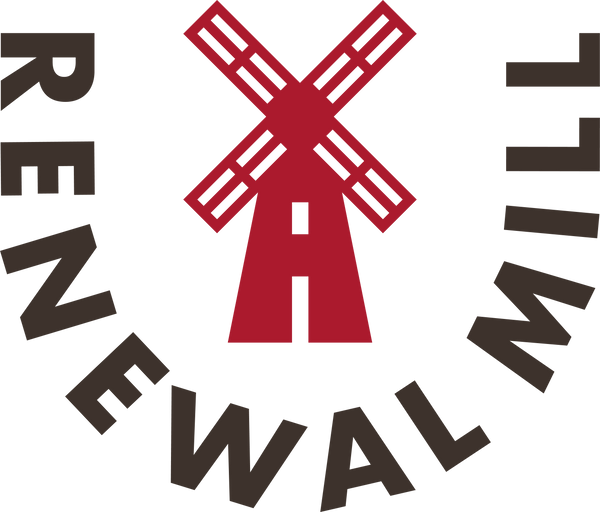Recipe by Alice Medrich
(Plant Based)
Surprise yourself. A rich little chocolate cake sans butter, eggs, dairy, or gluten! What
makes it good? Superb natural cocoa powder—and the best chocolate if you are making
the frosting— plus a couple of hidden baking tricks: use the right size pan and bake the
cake for 10 minutes longer than you might ordinarily! This little gem is mixed in one
bowl and way easier than pie. The cake is delicious enough to serve plain, with a dusting
of powdered sugar. You can accompany with fresh berries if you are so inclined. Or go
all the way with Vegan Chocolate Ganache.
Vegan/ GF Chocolate Fudge Cake
Serves 10-12
WHAT YOU NEED FOR THE CAKE
- 1 ½ cups (163g) Renewal Mill 1 to 1 Gluten Free Baking Flour
- 1 cup plus 1 tablespoon (214g) sugar
- ¼ cup plus 2 tablespoon (30g) unsweetened natural cocoa powder, sifted after measuring if lumpy
- 1 teaspoon baking soda
- ½ teaspoon salt
- 1 cup (236g) water
- ¼ cup (52g) neutral tasting oil (grapeseed or sunflower)
- 1 tablespoon apple cider or red wine vinegar
- 2 teaspoon pure vanilla extract
WHAT YOU NEED FOR THE VEGAN CHOCOLATE GANACHE
- 1 cup (260g) evaporated (not sweetened condensed) oat milk (see below for DIY)
- 8 ounces (225g) Tcho Bittersweet Baking Chocolate (66%) OR 10 ounces (280g) Guittard Akoma Chocolate Chips 55%
- 1/8 tsp salt (fine sea salt), or more to taste
- 1-2 tablespoons sugar, optional
- 1 teaspoon pure vanilla extract, or more to taste
DIY EVAPORATED SOY OR OTHER NON-DAIRY MILK
Simmer soy or other non-dairy milk until it is slightly less than 50% of the original amount.
Measure the milk in a glass measure, pour it into a saucepan. Keeping the measuring cup handy, simmer the milk it until it measures slightly less than half of what you started with.
For the Frosting above, just start with 2 ¼ cups of non-dairy milk and simmer it until it measures 1 cup.
EQUIPMENT
- 9-inch round or 8-inch square baking pan, greased on the sides and lined on the bottom with parchment paper
TO MAKE THE CAKE
Preheat the oven to 375F with a rack in the center.
Put the flour, sugar, cocoa, baking soda, and salt in a large bowl and whisk to blend.
Add water, oil, vinegar and vanilla and whisk for about a minute to make a thick blended
batter.
Scrape the batter into the prepared pan. Bake until a toothpick inserted in the center of the cake comes out clean and dry, 18-20 minutes.
Then, turn the oven temperature down to 300F and bake 10 minutes longer. Set the pan on a rack to cool for 10 minutes before removing it. Cool the cake completely before frosting, wrapping, or serving.
TO MAKE THE GANACHE/FROSTING
Put chocolate, vanilla, and salt into a medium bowl. Heat evaporated milk to a simmer and pour it over the chocolate.
Let stand for a minute or two to melt the chocolate. Whisk until the chocolate is completely melted and the mixture is smooth and glossy. Taste for salt and vanilla, adding a bit more of either to taste. You can also stir in additional sugar to round out the flavor or make it less intense.
Let the mixture stand until it has thickened to a soft swirl-able consistency. It takes a
while to thicken—put it in the fridge briefly if you are in a hurry. If the ganache gets to
stiff soften it gently in a pan of warm water—stirring until it is exactly the way you
want it to be pourable for a glaze, or spreadable for a frosting.
THE MORE YOU KNOW
Natural (non-alkalized) and Dutch-process (alkalized) cocoa powders are
interchangeable in recipes that do not contain a leavening such as baking powder or baking soda.
However, in recipes, such as this fudge cake, that do contain a leavening, and that specify a type of cocoa, is it important to use the type called for.
This is because natural cocoa is acidic and Dutch-process coca is close to neutral and these qualities interact with the leavening to produce the desired rise and flavor of the finished product. Our cake relies on the interaction of the vinegar, baking soda, with the acidity of natural cocoa powder.
How can you know whether your cocoa is natural or Dutch-process?
If the front of the package does not feature the words natural, or Dutch-process, turn to the ingredient list on the back. If you see the word “alkalized”, the cocoa is Dutch- process, otherwise the cocoa is natural.
Learn more here: Cocoa Powder 101 by Alice Medrich

